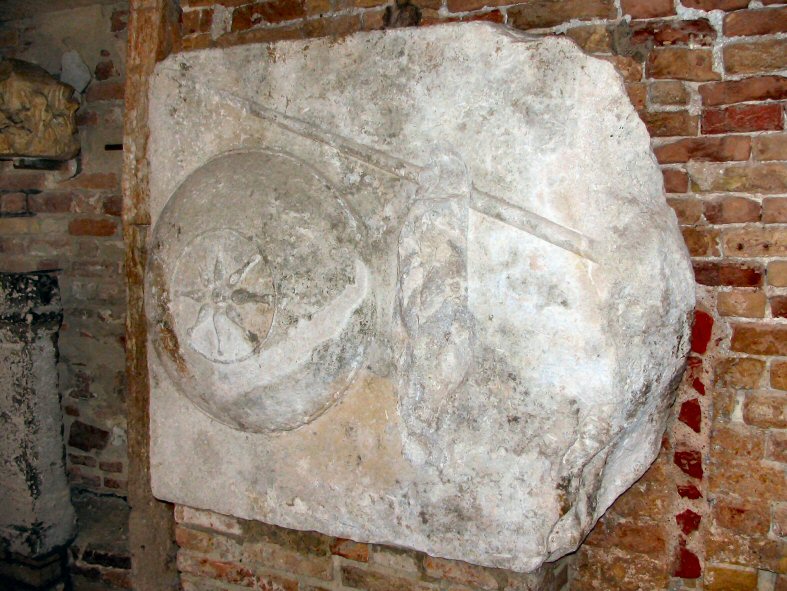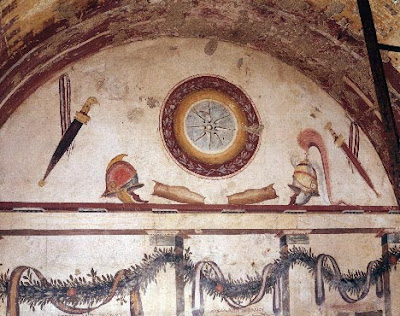Taphoi wrote: However, symmetry arguments would suggest that the spear shaft should have terminated at the original bottom righthand corner. If so, then this shaft was about 3.5m in length. The shield appears to be a lifesize phalangite type (diameter 70cm). Hence the "spear" would fall into the length range for a sarissa. The spearhead is actually quite similar to the spearhead discovered in the warrior grave at Aegae together with a "connector" and sauroter.
Firstly, that is damage to the stone to the right of the apsis? Difficult to make out just what it is.
Evidently the stone is rectangular and quite wide. I have not printed the photograph; merely measured where the “sarisa” would end in line with the bottom (extended) edge of the stone. If the aspis is 70cm my guesstimate is just short of 3 metres. That would make a 10 foot length. Were it 3.5 metres we have a spear of 11.5 feet. If these estimates are near to correct this is almost certainly a xyston of the sort depicted in the Kinch tomb or the Alexander mosaic.
The references to sarisae (Asclepiodotus / Theophrastus) indicate a length of between 15-18 feet or 4.6-5.4 metres. By the time of Polybius they had grown somewhat (18.29.2):
For since, when it has closed up for action, each man, with his arms, occupies a space of three feet in breadth, and the length of the pikes is according to the original design sixteen cubits (7.2m), but as adapted to actual need fourteen cubits (6.3m).
I don’t imagine we have a provenance for this stone? It would be interesting to know in which century it was sculpted. Why in Italy?
Either way, 3-3.5m is not long enough for a sarisa – if the measurements we are guessing are correct. One can imagine the Macedonian mustering officer exclaiming in a Sean Connery brogue: “Isn’t that just like an Amphipolitan; brings a xyston to a sarisa phalanx”.
Taphoi wrote: Not sure whether cornel or ash. What are the issues? Why not either or both, since it may have had two sections?
Sekunda quotes the famous passage (Hist. Plant. 3.12.1-2) from Theophrastus:
The wood of the male tree has no heart, but is hard throughout, like horn in closeness and strength; whereas that of the female tree has heartwood and is softer and goes into holes; wherefore it is useless for javelins. The height of the male tree is at most twelve cubits (5.4m), the length of the longest sarisa, the stem up to the point where it divides not being very tall.
Sekunda observes that the weapon actually under discussion is the javelin as the “female” tree is no good for making same. The male tree is though and is “at most” (that is, not always) the height of an 18 foot odd sarisa. The trunk is not – it splits early.
Sekunda’s argument (far more involved and citing much other evidence) is that the ash was a far more ready and reliable wood for the sarisa: easy to use and long of trunk. Such a tree enables the trunk to be split lengthwise providing many a “blank”.
Sekunda also addresses the pike point. The wide leaf shaped point claimed by Andronikos as sarisa is likely not. What is clear from the few descriptions of the weapon in use is that it was designed to penetrate defences: armour and shields. This is difficult to achieve with a wide blade. A narrower, smaller blade is much more adept at such work.
The shield is interesting: yet another “starburst”. Certainly could be phalangite at about 70cm though there are many shields in the archaeological record from hoplite aspis types to phalangite “pelte” and several in between (the deeply bowled types, etc). The "starburst" is not exactly that of the classic Macedonian type: they look like so many "nine-pins" as opposed to the quite pointed "rays" on extant Macedonian shield coverings, tomb art etc. Also no other decoration is present (or, as in the case of the successor kingdoms, dynast's "ID")



What is often forgotten is that the need to hold a sarisa with two hands did not mean a phalangite’s shield had to be 60-70cm. Larger shields were used as well.





